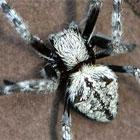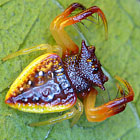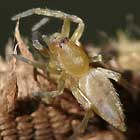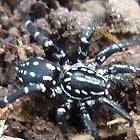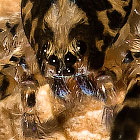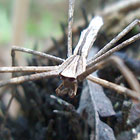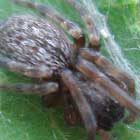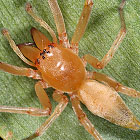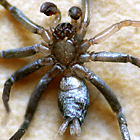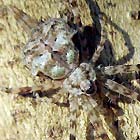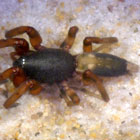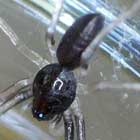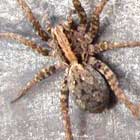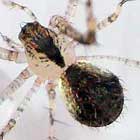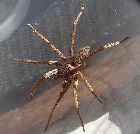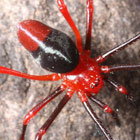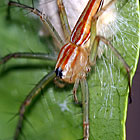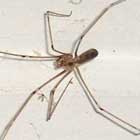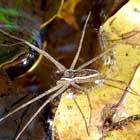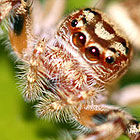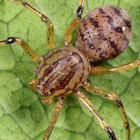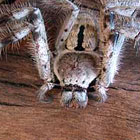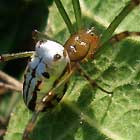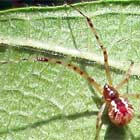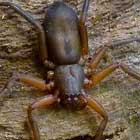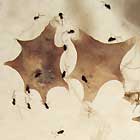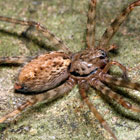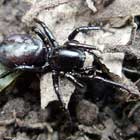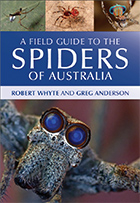Araneomorphs are the so-called modern spiders, having evolved later than the earliest spiders, the mygalomorphs. They are only modern in the sense of their more recent lineages, as living mygalomorphs must also be modern in the sense of being alive today. Araneomorphs have various characteristics which separate them from the mygalomorphs, which include having only one pair of book lungs and sometimes breathing tubes, whereas mygalomorphs have two pairs of book lungs. As a result mygalomorphs are restricted to moist environments with more or less constant access to water, while araneomorphs are more free living. There are many missing link spiders between the two groups.
- Home
- Araneomorphae
- ARANEIDAE Orb weavers
- ARKYIDAE Ambush Hunters
- CLUBIONIDAE Sac spiders
- CORINNIDAE Corinnids
- CTENIDAE Tropical Wolf Spiders
- DEINOPIDAE Net-casters
- DESIDAE Intertidal spiders
- CHEIRACANTHIIDAE Sac Spiders
- GNAPHOSIDAE Ground spiders
- HERSILIIDAE Two-tailed spiders
- LAMPONIDAE White-tails
- LINYPHIIDAE Sheet weavers
- LYCOSIDAE Wolf spiders
- MIMETIDAE Pirate spiders
- MITURGIDAE Prowling Hunters
- NICODAMIDAE Red-black spiders
- OXYOPIDAE Lynx spiders
- PHOLCIDAE Daddy long-legs
- PISAURIDAE Water spiders
- SALTICIDAE Jumping spiders
- SCYTODIDAE Spitting spiders
- SPARASSIDAE Huntsmans
- TETRAGNATHIDAE
- THERIDIIDAE Theridiids
- THOMISIDAE Crab spiders
- TROCHANTERIIDAE
- ULOBORIDAE Venomless spiders
- STIPHIDIIDAE
- ZODARIIDAE Ant spiders
- Mygalomorphae
- ACTINOPODIDAE Mouse Spiders
- ANAMIDAE Open-holed Trapdoor Spiders
- ATRACIDAE Sydney funnelweb and allies
- BARYCHELIDAE Brush-footed trapdoors
- DIPLURIDAE Masteria toddae
- EUAGRIDAE Curtain-web Spiders
- HALONOPROCTIDAE Cork-lid Trapdoors
- HEXATHELIDAE Bymainiella et al
- IDIOPIDAE True Trapdoor Spiders
- MICROSTIGMATIDAE Ixamatus et al
- MIGIDAE Tree Trapdoor SpIders
- PYCNOTHELIDAE Stanwellia
- THERAPHOSIDAE Whistling Tarantulas
- Obscure Spider Families
- AGELENIDAE Agelenid Spiders
- AMAUROBIIDAE Hackled-mesh Weavers
- AMMOXENIDAE Termite Hunters
- ANAPIDAE Tiny Orbweavers
- ANYPHAENIDAE Seashore Spiders
- ARCHAEIDAE Assassin Spiders
- AUSTROCHILIDAE Missing-link Spiders
- CITHAERONIDAE
- CYATHOLIPIDAE Cyatholipids
- DYSDERIDAE Louse Hunters
- FILISTATIDAE Crevice Weavers
- GALLIENIELLIDAE Gallieniellids
- GRADUNGULIDAE Long-claw spiders
- HAHNIIDAE Hahniids
- LIOCRANIDAE Spiny Sac Spiders
- MALKARIDAE Malkarids
- MYSMENIDAE Minute Litter Spiders
- OECOBIIDAE Flat-mesh weavers
- OONOPIDAE Goblin spiders
- ORSOLOBIDAE Orsolobids
- PHILODROMIDAE Philodromids
- PRODIDOMIDAE Prodidomids
- SELENOPIDAE Flatties
- SICARIIDAE Recluse Spiders
- TETRABLEMMIDAE Armoured Spiders
- ZOROPSIDAE False Wolf Spiders
Araneomorphae
Printable version | Rate this page
Home | Advanced Search | Araneomorphae | Mygalomorphae | Obscure Spider Families
ORDER ONLINE |
Site by ToadShow

